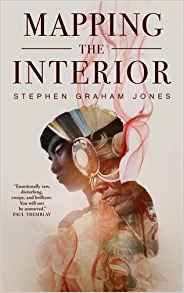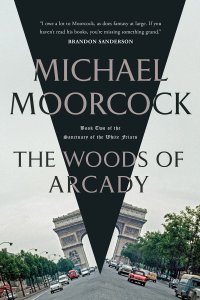John Langan Reviews Mapping the Interior by Stephen Graham Jones
 Mapping the Interior, Stephen Graham Jones (Tor.com Publishing 9780765395108, $10.99, 112pp, tp) June 2017.
Mapping the Interior, Stephen Graham Jones (Tor.com Publishing 9780765395108, $10.99, 112pp, tp) June 2017.
Mapping the Interior, Stephen Graham Jones’s astonishing novella, begins with the narrator sighting the ghost of his father. Twelve-year-old Junior lives in a small house with his widowed mother and younger brother, Dino, on a Native American reservation somewhere in the American west. His father has been dead for years, long enough ago that his older son’s memory of him is dim, faded. Yet when he wakes in the living room from the sleepwalking that has brought him there and sees a figure cross behind him, Junior immediately recognizes his father, despite him being dressed as a traditional Native dancer, what Junior thinks of as a fancydancer. It is a role his father never played, although one of Junior’s aunts has told him that his father aspired to become a dancer, once he gained control of his disordered life. Her brother, the aunt insists, would have been a great dancer, the greatest. So when Junior glimpses his father as a fancydancer, he sees him as he would like to have been, in his preferred identity.
While brief, this opening scene establishes many of the narrative’s concerns. Although a ghost story, it’s as much a tale of haunting, of the absences that bend and warp our lives. This begins with the name by which Junior is known, which describes him in relation to someone else. It expands to his sleepwalking, with its manifestation of the unconscious forces prompting him to movement. It includes his missing parent, and extends to not knowing the exact details of the parent’s death (Junior’s father drowned under ambiguous circumstances). It takes in individual dreams unrealized, and encompasses the larger heritage of a marginalized culture. (Indeed, throughout the novella, Junior remarks on aspects of Native American experience as it is daily lived, presenting it as a series of displacements, deferments, and disappointments.) Rather than an exception, Junior’s father’s ghost is the culmination of the blanks in his life.
However, Junior is not horrified by the specter; just the opposite, in fact. He is happy at the thought that his father is watching over him, eager for confirmation of the visitation. He pores over the spot where he saw his father, searching for the slightest trace of him. He is strict with his younger brother, trying to demonstrate that he is a responsible older brother. He asks his mother about his father.
In the meantime, he navigates the challenges of his day to day life, from the seizures which afflict Dino, and which seem to be worsening, to the hostile neighborhood dogs and their equally hostile owner, to his mother’s interest in a local sheriff’s deputy. Eventually, his investigations lead him under the house, to very physical evidence of the means of his father’s return. Soon thereafter, Junior begins to realize that his father may not be the benevolent figure he had hoped for, as the novella steers into darker terrain. Its extended climax is a one-two punch of renunciation and then betrayal that stabs through the heart like an icepick, and remains there, quivering.
In his earlier novel, It Came from Del Rio, Jones managed to pack the narrative drive and emotional power of a 1980s doorstop horror novel into a couple of hundred pages. Mapping the Interior repeats this feat, employing a loose, conversational prose that turns up phrases and sentences of stark resonance. As a meditation on identity – personal, familial, and cultural – as an original approach to the ghost story, it is a tremendous achievement. With Mongrels, Jones wrote one of the books of 2016; with Mapping the Interior, he has done the same for 2017.
John Langan is the author of two novels, The Fisherman (2016) and House of Windows (Night Shade 2009), and two collections of stories, The Wide Carnivorous Sky and Other Monstrous Geographies (2013) and Mr. Gaunt and Other Uneasy Encounters (2008). With Paul Tremblay, he co-edited Creatures: Thirty Years of Monsters (2011). One of the founders of the Shirley Jackson Awards, he served as a juror for its first three years. He lives in New York’s Mid-Hudson Valley with his wife and younger son.
This review and more like it in the January 2018 issue of Locus.








